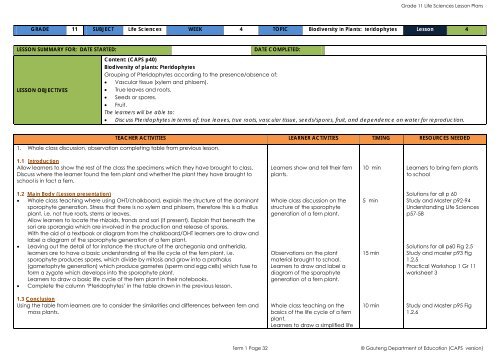Life Science Grade 11
Life Science Grade 11
Life Science Grade 11
You also want an ePaper? Increase the reach of your titles
YUMPU automatically turns print PDFs into web optimized ePapers that Google loves.
<strong>Grade</strong> <strong>11</strong> <strong>Life</strong> <strong>Science</strong>s Lesson PlansGRADE <strong>11</strong> SUBJECT <strong>Life</strong> <strong>Science</strong>s WEEK 4 TOPIC Biodiversity in Plants: teridophytes Lesson 4LESSON SUMMARY FOR: DATE STARTED:LESSON OBJECTIVESDATE COMPLETED:Content: (CAPS p40)Biodiversity of plants: PteridophytesGrouping of Pteridophytes according to the presence/absence of:• Vascular tissue (xylem and phloem).• True leaves and roots.• Seeds or spores.• Fruit.The learners will be able to:• Discuss Pteridophytes in terms of: true leaves, true roots, vascular tissue, seeds/spores, fruit, and dependence on water for reproduction.TEACHER ACTIVITIES LEARNER ACTIVITIES TIMING RESOURCES NEEDED1. Whole class discussion, observation completing table from previous lesson.1.1 IntroductionAllow learners to show the rest of the class the specimens which they have brought to class.Discuss where the learner found the fern plant and whether the plant they have brought toschool is in fact a fern.Learners show and tell their fernplants.10 minLearners to bring fern plantsto school1.2 Main Body (Lesson presentation)• Whole class teaching where using OHT/chalkboard, explain the structure of the dominantsporophyte generation. Stress that there is no xylem and phloem, therefore this is a thallusplant, i.e. not true roots, stems or leaves.Allow learners to locate the rhizoids, fronds and sori (if present). Explain that beneath thesori are sporangia which are involved in the production and release of spores.With the aid of a textbook or diagram from the chalkboard/OHT learners are to draw andlabel a diagram of the sporophyte generation of a fern plant.• Leaving out the detail of for instance the structure of the archegonia and antheridia,learners are to have a basic understanding of the life cycle of the fern plant, i.e.sporophyte produces spores, which divide by mitosis and grow into a prothalus(gametophyte generation) which produce gametes (sperm and egg cells) which fuse toform a zygote which develops into the sporophyte plant.Learners to draw a basic life cycle of the fern plant in their notebooks.• Complete the column ‘Pteridophytes’ in the table drawn in the previous lesson.Whole class discussion on thestructure of the sporophytegeneration of a fern plant.Observations on the plantmaterial brought to school.Learners to draw and label adiagram of the sporophytegeneration of a fern plant.5 min15 minSolutions for all p 60Study and Master p92-94Understanding <strong>Life</strong> <strong>Science</strong>sp57-58Solutions for all p60 Fig 2.5Study and master p93 Fig1.2.5Practical Workshop 1 Gr <strong>11</strong>worksheet 31.3 ConclusionUsing the table from learners are to consider the similarities and differences between fern andmoss plants.Whole class teaching on thebasics of the life cycle of a fernplant.Learners to draw a simplified life10 minStudy and Master p95 Fig1.2.6Term 1 Page 32© Gauteng Department of Education (CAPS version)







